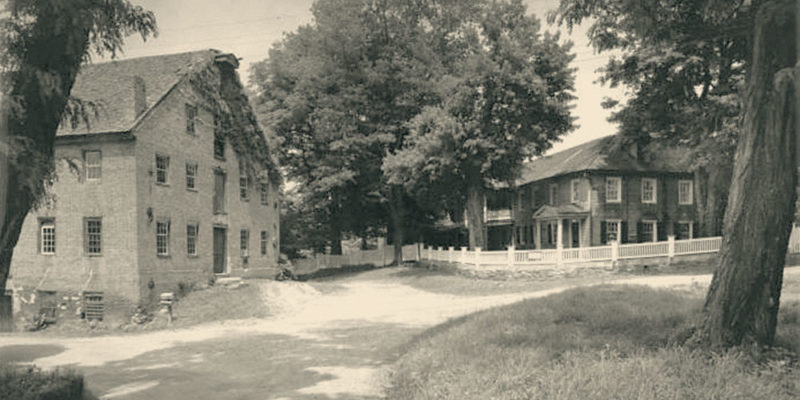A Business is Born and Prospers
In early 1797, two brothers took ownership of a tract of land along Big Pipe Creek in what was then Frederick (now Carroll) County, Maryland in a joint enterprise between the brothers. The brothers intended to combine their respective skills in a business enterprise centered on a set of water-powered mills to be built on the property, which was about seven miles north of Westminster and along early roads leading to Littlestown and Pennsylvania’s roads towards the west. Big Pipe Creek furnished a strong flow of water for a mill in the wide valley, and gentle slopes on either side provided land for grazing, farming, or settlement. Abundant groves of oak provided bark for the tanning of leather and wood for lumber. Business was successful, the family prospered, and they expanded their businesses and real estate holdings.
// LEARN MORE ABOUT THE MILL
The House is Built
On January 26, 1797, the brothers signed a contract with Henry Kohlstock of York County, Pennsylvania, for building a small four-room double house as their combined residence. Kohlstock, a joiner, agreed “to finish two small houses 14 by 17 feet each, to be connected by a porch and passage about 10 feet wide.” Each side of the house had one upper and one lower room, with a connecting center hallway and a small porch in front, twelve by eight feet.
The original four-room house, which both brothers (and Andrew’s family) shared for a few years, received additions over time as the needs of the growing household of Andrew Shriver and his descendants required. Eventually, a sprawling country mansion of 23 rooms came to occupy the site, surrounded by outbuildings, gardens, and orchards. Six generations of the family lived at the site through the 1960s. Their home is still standing, complete with original furnishings and family possessions.
// LEARN MORE ABOUT THE SHRIVER FAMILY
The Museum Opens
In 1950, the Union Mills house came into the hands of three brothers, Frederic Shriver Klein, Philip Shriver Klein, and Richard Henry Klein, the fifth generation of the Shriver family to own the property, subject to a life estate of their aunt, Elizabeth (Bessy) Shriver Kemp, who continued to live in the Homestead until her death in 1957. Two of the three brothers were professors of American History, and they had a keen sense of the genuine historic value of the property and its artifacts. In 1954, the Klein brothers reached an agreement with the B.F. Shriver Co. by which the mill on the property was transferred to them as well; the mill had been owned by another line of Shriver descendants since 1853.
Living at Union Mills in the summers, the Kleins began operating Union Mills as a museum of American rural culture. The Kleins decided to do little to the house, generally leaving the furniture and the objects of everyday living just where the generations of Shrivers who occupied the house before them had left them. The mill housed a Mill Museum, with displays of antique farming equipment and Civil War relics.
The Foundation is Launched
On October 11, 1964, the Kleins established the Union Mills Homestead Foundation, Inc. to operate, preserve, and maintain the Union Mills Homestead and to secure appropriate preservation funding. In ensuing years, the Kleins and the Foundation transferred by donation and sale the structures and real property to the Carroll County Government. The County, in turn, leased the property back to the Foundation. By similar arrangements, ownership of the physical artifacts was transferred to the Foundation, as well. The Foundation’s operation of the site continues today in accordance with these agreements.
// LEARN MORE ABOUT THE FOUNDATION
Restoration Begins
In early 1973, with grant funding from the U.S. Department of Housing and Urban Development, the house and mill were stabilized and restored. Ten years later, in May 1983, and with additional grants from the State of Maryland, Carroll County, and gifts from the membership, the mill was restored to working order, its machinery painstakingly recreated by British engineer-turned-millwright Derek Ogden. Restoration of the mill dramatically increased historic interest in the site.
Other structures have been restored as well. In 1986, the Foundation re-opened the Miller’s House as a visitor center and gift shop, and the Tannery underwent renovation to serve as both storage space and a meeting hall. After being destroyed in an arson fire on October 25, 1990, the remaining portion of the Tannery was completely re-built using traditional construction techniques, including a replica of the original sundial painted on the Tannery wall in the 1860s. The bark shed near the Tannery has become a demonstration site for nineteenth century crafts. The gardens and grounds have been restored to reflect the life of an earlier era.

